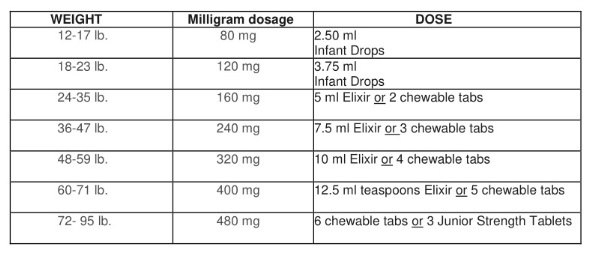Tylenol and Ibuprofen Dosage
/ACETAMINOPHEN (TYLENOL)
DOSAGE (every 4-6 hours) :
The enclosed syringe with the infant drops is designed to provide 1.25 ml ( 40 mg) increments.
IBUPROFEN ( ADVIL, MOTRIN)
DOSAGE (every 6-8 hours):

ACETAMINOPHEN (TYLENOL)
DOSAGE (every 4-6 hours) :
The enclosed syringe with the infant drops is designed to provide 1.25 ml ( 40 mg) increments.

IBUPROFEN ( ADVIL, MOTRIN)
DOSAGE (every 6-8 hours):


It is the law in Massachusetts that infants and children must ride buckled in car seats or seat belts. Using the proper car seat correctly does make a difference.
There is no one brand that everyone agrees is “safest” or “best”. The “best” car seat for your baby is one that fits your child’s size and weight, fits in your car, and that you will use correctly on every ride.
The price of the car seat does not usually make a difference in the safety of the seat. Higher prices often mean added features that may or may not make the seat easier to use.
When you purchase a new car seat, make sure you send the registration card to the manufacturer so that they can let you know of any problems or recalls.
Use your car seat on every ride, starting with your baby’s first trip home from the hospital. Help your child form a lifelong habit of buckling up!
Remember: the seat belt holds the car seat in the car and the harness or shield holds your child in the car seat. Unless both are attached snugly, the car seat may not protect your child!!
Look for a car seat with harnesses that are easy to adjust when the seat is in the car.
To keep a newborn from slouching, pad the sides of the seat and between the legs with rolled up diapers, towels or receiving blankets. If your infant’s head flops forward, tilt the seat back until it is level by wedging firm padding under the front of the base of the seat.
Most new cars have air bags for front seat passengers.
Air bags are NOT SAFE when used with rear-facing car seats. If your car has a passenger-side air bag, infant seats (which always face the back of the car) and rear-facing convertible seats MUST be placed in the back seat.
Even a toddler who is in a forward-facing car seat, a booster seat, or a lap/shoulder seat belt is at risk from air bag injuries. The rear seat is the safest place for a child of any age to ride.
Infant Car Seats
These can be used from birth to at least 20 pounds and about 1 year of age. They must then be replaced by a convertible seat when the baby outgrows the seat. Remember, infant seats are always used rear-facing.
Convertible Car Seats
These can be used from birth to about 40 pounds. These are seats that are used rear-facing for infants and forward-facing for toddlers. Infants should ride rear-facing until 2 years old. Recent studies now suggest that the rear-facing position is actually the safest until about age 2. Many convertible car seats will not fit newborn infants well.
Convertible seats have three types of harnesses:
5-Point Harness– five straps: two at the shoulders, two at the hips, one at the crotch
T-Shield- a padded T-shaped or triangular shield attached toshoulder straps that buckles into the seat at the crotch.
Overhead or Tray-Shield– a padded, tray-like shield that swings down around the child.
For small newborns, shields are often too high and too far from the body to fit correctly. A 5-point harness fits small newborns better because it can be adjusted to fit snugly.
Booster Seats
These are designed for children who have outgrown convertible seats and should be used until approximately 8 years old.
Shield Boosters
Do NOT use shield boosters for children under 40 pounds, even if they are labeled for use at a lower weight. Shield boosters do not provide as much body protection as belt-positioning boosters.
Belt-Positioning Boosters
Use a belt- positioning booster if your vehicle has both lap and shoulder belts. The booster raises your child up so that the lap and shoulder belts fit properly. Be sure to keep the lap belt tight and low across your child’s hips and make sure the shoulder belt lies flat across the shoulder, away from the neck and face.
Check instructions to make sure the belt is in the correct path.
Make sure the belt that is holding the car seat in place is tight enough by pushing on the car seat. It should not move easily from side to side or forward.
Keep your child in a convertible or booster seat for as long as possible. (usually 60-80 pounds). However, if your child has outgrown the booster seat, be sure the seat belt in your vehicle fits your child correctly. The shoulder belt should fit across the shoulder and the lap belt must lie low and flat across the hips. Never tuck the shoulder belt under the child’s arm or behind the back.
Was made before January 1981.
Was ever in a crash.
Does not have a label with the date of manufacture and model number (in case of recall).
Does not come with instructions for proper installation.
Has any visible cracks in the frame of the seat.
Is missing parts.
Auto Safety Hotline: 1-888-DASH-2-DOT or online at www.nhtfa.gov
We are constantly working to raise the bar on our services. If you have any questions or concerns about your experience, please contact our office to let us know.












2020 Centre St., Boston, MA, 02132
Powered by Squarespace.